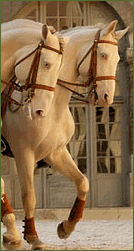|
The work on the stables of Versailles started in 1679 and was
completed by 1683, and these two buildings were not just outstanding because of their
dimensions, but because of the incredible architecture and quality of the sculptured
decoration, plus they also enclose the Military's practice area, which is known as the
Place d'Armes.
The Grand Stable
Although it is named the Grand stable, it is actually the same size as the small stable,
but owes its name to the fact it was placed under the authority of the Grand
Equerry. It was the Grand Equerry who had the responsibility for the horses and
these specially trained horses were raised to the art of hunting and that of war and were
strictly reserved for the kings and princes.
But within the Grand Stable today, one of the galleries shelters the Musée des Carrosses, which is a the
remarkable Coach Museum brought about by
King Louis-Philippe.
The Little Stable
It was the First Equerry that was in charge of the Little Stable and it sheltered the
coaches, carriages and carriage horses. But also within these stables were the
ordinary mounts that were at the Court's disposal.
The art of dressage, which always instils a sense of courage and skill, reached its
highlight in Versailles in the middle of 18th century and this art also became a way of
entertainment.
King Louis XIV had a strong passion for the most elaborate equestrian art performances and you can see
this reflected in the magnificence of the carousels, for example, and the Grand Stable and
its outdoor arena hosted many royal festivities, including theatre and opera performances
in the big central arena. There was even a theatre erected by Slodtz and
Perrot in 1745 for Dauphin's wedding, but unfortunately, seven years later this theatre
perished in a fire and after this the arena continued to deteriorate until its structure
eventually collapsed at the end of King Louis XVI's reign.
Keen to reinstate the horses and pageboys that had been scattered by the Revolution,
Napoleon I had the Grand Stable restored, but unfortunately it was closed again when the
Kings decided not to live at Chateau de Versailles
any longer.
In 1855 the architect Charles Questel had the arena completely reconstructed and then from
the place being left vacant by the former outdoor arena, it was used to accommodate
artillery barracks and big workshops manufacturing gun carriages. So now that it was
in the hands of the Army, in the aftermath of the Commune's uprising the Grand Stable was
partly used by the military justice as offices and the war councils in charge of the
Communards' trials, sat in the arena.
The army gradually evacuated the premises between 1950 and 1965 and in the 1970's, the
Grand Stable was restored to its initial architectural footprint after around a century of
decay.
The Stables have been superbly restored to host the Académie du Spectacle Equestre and its
thirty plus horses, to bring back the tradition of horsemanship and dressage back to
Chateau de Versailles and are just another part of this fabulous place that you can get to
visit.
Now please bear in mind that the Chateau de Versailles near Paris is closed on a Monday and you would also need to
contact the Musée des Carrosses for details of when they are open so you can view these
prestigious coaches that are in the collection.
Also, to visit the stable where the horses are kept, you would need to contact the
Académie du Spectacle Equestre, as you can have a tour of the stables after the
performances and shows that they conduct at set times during the week.
Address & Contact Details:
Grande Écurie du Château de Versailles
Avenue Rockfeller
78000
Versailles
France
|
|



